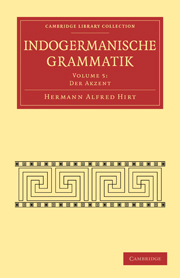Book contents
- Frontmatter
- Vorwort
- Contents
- Einleitung
- Erster Teil. Der Akzent der Einzelsprachen
- IV Kapitel. Das Griechische
- V Kapitel. Das Lateinische
- VI Kapitel. Das Keltische
- VII Kapitel. Das Germanische
- VIII Kapitel. Das Baltische
- IX Kapitel. Das Slawische
- X Kapitel. Die litu-slawischen Intonationen
- XI Kapitel. Der Hauptton im Litu-Slawischen im Vergleich zum Indogermanischen
- XII Kapitel. Das Armenische
- XIII Kapitel. Das Albanische
- XIV Kapitel. Das Indische
- XV Kapitel. Das Iranische
- Zweiter Teil. Der Akzent des Indogermanischen
- Autorenverzeichnis
- Sachregister
- Wörterverzeichnis
V - Kapitel. Das Lateinische
Published online by Cambridge University Press: 05 August 2011
- Frontmatter
- Vorwort
- Contents
- Einleitung
- Erster Teil. Der Akzent der Einzelsprachen
- IV Kapitel. Das Griechische
- V Kapitel. Das Lateinische
- VI Kapitel. Das Keltische
- VII Kapitel. Das Germanische
- VIII Kapitel. Das Baltische
- IX Kapitel. Das Slawische
- X Kapitel. Die litu-slawischen Intonationen
- XI Kapitel. Der Hauptton im Litu-Slawischen im Vergleich zum Indogermanischen
- XII Kapitel. Das Armenische
- XIII Kapitel. Das Albanische
- XIV Kapitel. Das Indische
- XV Kapitel. Das Iranische
- Zweiter Teil. Der Akzent des Indogermanischen
- Autorenverzeichnis
- Sachregister
- Wörterverzeichnis
Summary
Geschichtliches und Literatur. Das Lateinische zeigt uns ein typisches Beispiel einer ≪gebundenen≫ Betonung. Bekanntlich liegt der Ton auf der vorletzten und nur, wenn diese kurz ist, auf der drittletzten Silbe. Da also zunächst nichts dem Idg. vergleichbares vorhanden ist, könnte es fast ganz auscheiden. Aber bei dem Akzent handelt es sich nicht nur um die Betonung einer Silbe, sondern um eine Fülle von Eigentümlichkeiten, und in dieser Beziehung bietet auch das Lateinieche mancherlei.
Naturgemäβ wandten sich zunächst die klassischen Philologen den Fragen auf diesem Gebiete zu. Indessen das Werk von H. Weil und L. Benloew, Théorie générale de l'accentuation latine suivie de recherches sur les inscriptions accentuées et d'un examen des vues de Bopp sur l'histoire de l'accent, Berlin, Paris 1855 hat heute keine Bedeutung mehr. — Von auβerordentlichem Werte war es, als im Jahre 1852 etwa A. Dietrich, KZ. 1, 543 ff. entdeckte, daβ der geschichtlichen Betonung des Lateinischen eine andere Art vorausgegangen war, daβ der Ton in vielen Fällen auf der ersten Silbe des Wortes geruht habe.
In seinem groβen, seinerzeit recht verdienstlichen und noch heute brauchbaren Werk Über Aussprache, Vokalismus und Betonung der lat. Sprache, 1858, 2. Auflage 1868—70 hat W. Corssen Bd. 2 892 ff. dies ältere Betonungsgesetz durch ein reiches, freilich in vielen Fällen nicht zutreffendes Material erhärtet, sowie überhaupt den Akzent ausführlich behandelt. […]
- Type
- Chapter
- Information
- Indogermanische Grammatik , pp. 67 - 82Publisher: Cambridge University PressPrint publication year: 2009First published in: 1929



